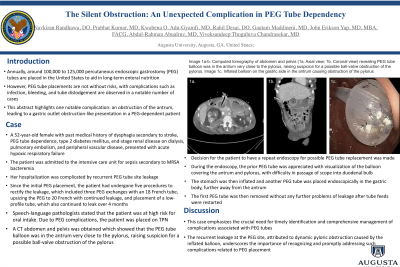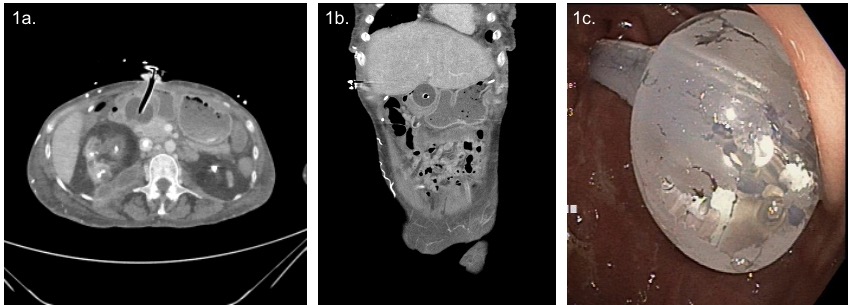Monday Poster Session
Category: Small Intestine
P3310 - The Silent Obstruction: An Unexpected Complication in PEG Tube Dependency
Monday, October 28, 2024
10:30 AM - 4:00 PM ET
Location: Exhibit Hall E

Has Audio
- NR
Navkiran Randhawa, DO
Medical College of Georgia at Augusta University
Augusta, GA
Presenting Author(s)
Navkiran Randhawa, DO1, Prabhat Kumar, MD2, Kwabena O. Adu-Gyamfi, MD3, Rahil Desai, DO4, Gautam Maddineni, MD5, John Erikson Yap, MD, MBA, FACG6, Abdul-Rahman Abualruz, MD3, Viveksandeep Thoguluva Chandrasekar, MD1
1Medical College of Georgia at Augusta University, Augusta, GA; 2Cleveland Clinic Foundation, Cleveland, OH; 3Medical College of Georgia, Augusta University, Augusta, GA; 4Franciscan Health Olympia Fields, Chicago, IL; 5Florida State University, Cape Coral, FL; 6Metrodora Institute, West Valley City, UT
Introduction: Annually, around 100,000 to 125,000 percutaneous endoscopic gastrostomy (PEG) tubes are placed in the United States to aid in long-term enteral nutrition. However, PEG tube placements are not without risks, with complications such as infection, bleeding, and tube dislodgement are observed in a notable number of cases. This abstract highlights one notable complication: an obstruction of the antrum, leading to a gastric outlet obstruction-like presentation in a PEG-dependent patient.
Case Description/Methods: A 52-year-old female with past medical history of dysphagia secondary to stroke, PEG tube dependence, type 2 diabetes mellitus, end-stage renal disease on dialysis, pulmonary embolism, and peripheral vascular disease, presented with acute hypoxic respiratory failure. The patient was admitted to the intensive care unit for sepsis secondary to MRSA bacteremia. Her hospitalization was complicated by recurrent PEG tube site leakage. Since the initial PEG placement, the patient had undergone five procedures to rectify the leakage, which included three PEG exchanges with an 18 French tube, upsizing the PEG to 20 French with continued leakage, and placement of a low-profile tube, which also continued to leak over 4 months. Speech-language pathologists stated that the patient was at high risk for oral intake. Due to PEG complications, the patient was placed on TPN. A CT abdomen and pelvis was obtained which showed that the PEG tube balloon was in the antrum very close to the pylorus, raising suspicion for a possible ball-valve obstruction of the pylorus. Decision for the patient to have a repeat endoscopy for possible PEG tube replacement was made. During the endoscopy, the prior PEG tube was appreciated with visualization of the balloon covering the antrum and pylorus, with difficulty in passage of scope into duodenal bulb. The stomach was then inflated and another PEG tube was placed endoscopically in the gastric body, further away from the antrum. The first PEG tube was then removed without any further problems of leakage after tube feeds were restarted.
Discussion: This case emphasizes the crucial need for timely identification and comprehensive management of complications associated with PEG tubes. The recurrent leakage at the PEG site, attributed to dynamic pyloric obstruction caused by the inflated balloon, underscores the importance of recognizing and promptly addressing such complications related to PEG placement.

Disclosures:
Navkiran Randhawa, DO1, Prabhat Kumar, MD2, Kwabena O. Adu-Gyamfi, MD3, Rahil Desai, DO4, Gautam Maddineni, MD5, John Erikson Yap, MD, MBA, FACG6, Abdul-Rahman Abualruz, MD3, Viveksandeep Thoguluva Chandrasekar, MD1. P3310 - The Silent Obstruction: An Unexpected Complication in PEG Tube Dependency, ACG 2024 Annual Scientific Meeting Abstracts. Philadelphia, PA: American College of Gastroenterology.
1Medical College of Georgia at Augusta University, Augusta, GA; 2Cleveland Clinic Foundation, Cleveland, OH; 3Medical College of Georgia, Augusta University, Augusta, GA; 4Franciscan Health Olympia Fields, Chicago, IL; 5Florida State University, Cape Coral, FL; 6Metrodora Institute, West Valley City, UT
Introduction: Annually, around 100,000 to 125,000 percutaneous endoscopic gastrostomy (PEG) tubes are placed in the United States to aid in long-term enteral nutrition. However, PEG tube placements are not without risks, with complications such as infection, bleeding, and tube dislodgement are observed in a notable number of cases. This abstract highlights one notable complication: an obstruction of the antrum, leading to a gastric outlet obstruction-like presentation in a PEG-dependent patient.
Case Description/Methods: A 52-year-old female with past medical history of dysphagia secondary to stroke, PEG tube dependence, type 2 diabetes mellitus, end-stage renal disease on dialysis, pulmonary embolism, and peripheral vascular disease, presented with acute hypoxic respiratory failure. The patient was admitted to the intensive care unit for sepsis secondary to MRSA bacteremia. Her hospitalization was complicated by recurrent PEG tube site leakage. Since the initial PEG placement, the patient had undergone five procedures to rectify the leakage, which included three PEG exchanges with an 18 French tube, upsizing the PEG to 20 French with continued leakage, and placement of a low-profile tube, which also continued to leak over 4 months. Speech-language pathologists stated that the patient was at high risk for oral intake. Due to PEG complications, the patient was placed on TPN. A CT abdomen and pelvis was obtained which showed that the PEG tube balloon was in the antrum very close to the pylorus, raising suspicion for a possible ball-valve obstruction of the pylorus. Decision for the patient to have a repeat endoscopy for possible PEG tube replacement was made. During the endoscopy, the prior PEG tube was appreciated with visualization of the balloon covering the antrum and pylorus, with difficulty in passage of scope into duodenal bulb. The stomach was then inflated and another PEG tube was placed endoscopically in the gastric body, further away from the antrum. The first PEG tube was then removed without any further problems of leakage after tube feeds were restarted.
Discussion: This case emphasizes the crucial need for timely identification and comprehensive management of complications associated with PEG tubes. The recurrent leakage at the PEG site, attributed to dynamic pyloric obstruction caused by the inflated balloon, underscores the importance of recognizing and promptly addressing such complications related to PEG placement.

Figure: Image 1a-b. Computed tomography of abdomen and pelvis (1a. Axial view; 1b. Coronal view) revealing PEG tube balloon was in the antrum very close to the pylorus, raising suspicion for a possible ball-valve obstruction of the pylorus.
Image 1c. Inflated balloon on the gastric side in the antrum causing obstruction of the pylorus
Image 1c. Inflated balloon on the gastric side in the antrum causing obstruction of the pylorus
Disclosures:
Navkiran Randhawa indicated no relevant financial relationships.
Prabhat Kumar indicated no relevant financial relationships.
Kwabena Adu-Gyamfi indicated no relevant financial relationships.
Rahil Desai indicated no relevant financial relationships.
Gautam Maddineni indicated no relevant financial relationships.
John Erikson Yap indicated no relevant financial relationships.
Abdul-Rahman Abualruz indicated no relevant financial relationships.
Viveksandeep Thoguluva Chandrasekar indicated no relevant financial relationships.
Navkiran Randhawa, DO1, Prabhat Kumar, MD2, Kwabena O. Adu-Gyamfi, MD3, Rahil Desai, DO4, Gautam Maddineni, MD5, John Erikson Yap, MD, MBA, FACG6, Abdul-Rahman Abualruz, MD3, Viveksandeep Thoguluva Chandrasekar, MD1. P3310 - The Silent Obstruction: An Unexpected Complication in PEG Tube Dependency, ACG 2024 Annual Scientific Meeting Abstracts. Philadelphia, PA: American College of Gastroenterology.
